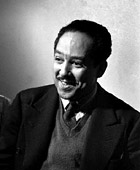 One of Hughes' most acclaimed essays appeared in the Nation in 1926, entitled "The Negro Artist and the Racial Mountain". It spoke of Black writers and poets, "who would surrender racial pride in the name of a false integration," where a talented Black writer would prefer to be considered a poet, not a Black poet, which to Hughes meant he subconsciously wanted to write like a white poet. Hughes argued, "no great poet has ever been afraid of being himself."
One of Hughes' most acclaimed essays appeared in the Nation in 1926, entitled "The Negro Artist and the Racial Mountain". It spoke of Black writers and poets, "who would surrender racial pride in the name of a false integration," where a talented Black writer would prefer to be considered a poet, not a Black poet, which to Hughes meant he subconsciously wanted to write like a white poet. Hughes argued, "no great poet has ever been afraid of being himself."  Langston Hughes in 1936 Hughes' travels ranged to such diverse locations as Senegal, Nigeria, the Cameroons, the Belgian Congo, Angola, and Guinea in Africa; to Italy, France, Russia and Spain. Whether abroad, or at home in the US, Hughes loved to sit in the clubs listening to blues, jazz and writing poetry. A 'new rhythm' emerged in his writing, as evidenced by his collection of poems, "The Weary Blues". Returning to live in Harlem in 1924 -during a period often referred to as the 'Harlem Renaissance'- his work was frequently published and he wrote prolifically. Moving to Washington D.C., in 1925, his time spent in blues and jazz clubs increased even further.
Langston Hughes in 1936 Hughes' travels ranged to such diverse locations as Senegal, Nigeria, the Cameroons, the Belgian Congo, Angola, and Guinea in Africa; to Italy, France, Russia and Spain. Whether abroad, or at home in the US, Hughes loved to sit in the clubs listening to blues, jazz and writing poetry. A 'new rhythm' emerged in his writing, as evidenced by his collection of poems, "The Weary Blues". Returning to live in Harlem in 1924 -during a period often referred to as the 'Harlem Renaissance'- his work was frequently published and he wrote prolifically. Moving to Washington D.C., in 1925, his time spent in blues and jazz clubs increased even further. ![[Photograph: Langston Hughes by Gordon Parks, 1943, Library of Congress]](http://www.kansasheritage.org/crossingboundaries/images/hughes2.jpg) In 1942, during World War II, Hughes began writing a column for the African American newspaper, the Chicago Defender. In 1943 he introduced the character of Jesse B. Semple, or Simple, to his readers. This fictional everyman, while humorous, also allowed Hughes to discuss very serious racial issues. The Simple columns were also popular--and they ran for twenty years and were collected in several books.
In 1942, during World War II, Hughes began writing a column for the African American newspaper, the Chicago Defender. In 1943 he introduced the character of Jesse B. Semple, or Simple, to his readers. This fictional everyman, while humorous, also allowed Hughes to discuss very serious racial issues. The Simple columns were also popular--and they ran for twenty years and were collected in several books.Child's Tale About Race Has a Tale Of Its Own
In December 1934, the poet Langston Hughes went to Mexico City to wrap up the business affairs of his late father, James, only to discover that he had been disinherited. Father and son had had a difficult relationship.